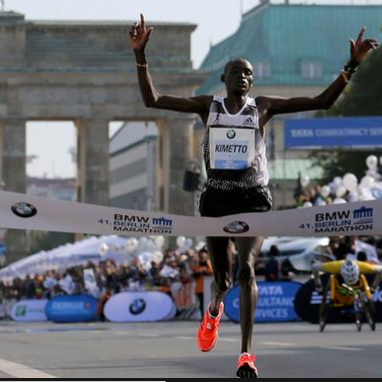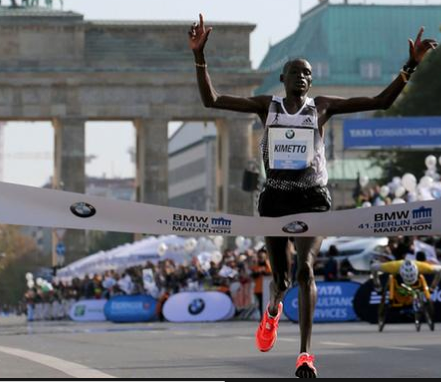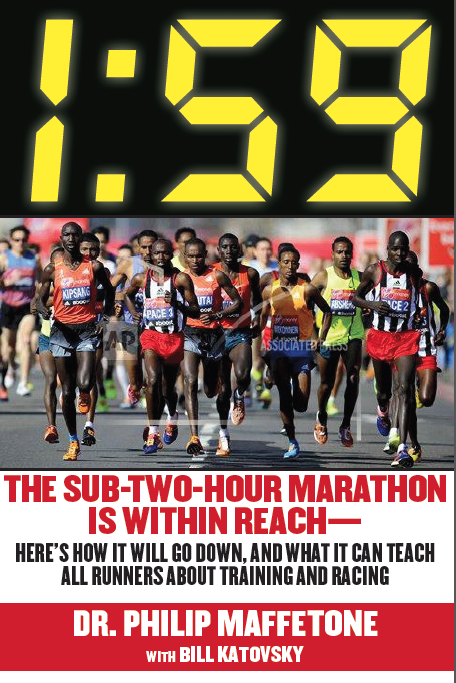With his day-glo orange racing flats flashing through the Berlin streets, Kenyan Dennis Kimetto blazed to a world record 2:02:57 marathon. The weather did not hinder his pace, and it may not have helped much either, as other race times were not particularly quick (third-place men’s time was almost 2:06, and the women’s race was won in over 2:20). This made Kimetto’s victory more him and less Mother Nature. The traditionally fast flat course in Berlin frequently sets up great race times. But on this day, the world record was only one of the important features of his day.
The morning after the great race finds many more runners, including those in the media, coaches and sports scientists, not just talking sub-two hours, but believing in it. Beyond the fact that Kimetto’s time was a world record, other factors helped fuel the 1:59 bandwagon, which, from this point on, will gain speed and build like a blazing runner in their final kick before breaking the tape.
Only recently have media questions started being seriously asked about a sub two-hour marathon. Such was the case in Berlin. Post-race, both Kimetto, and runner up Emmanuel Mutai, who also ran under the now old world record, were asked about it. The two fastest marathoners in history were clear and confident: “I am expecting a marathon in two hours,” said Kimetto. Mutai agreed, claiming, “Today showed that the time is coming down and down. To beat two hours is possible.”
In my analysis of the world’s top marathoners, which I made last winter when writing the book, “1:59,” there were only a few who are most likely to go under two-hours. That analysis was based on various factors such as fitness, health and age. Along with Kimetto, Geoffrey Mutai and Wilson Kipsang (who happen to all be training partners) are in the lead pack of potential candidates. (No doubt other candidates are closing in, including non-East Africans from around the globe.)
The talk of the running world was that Kimetto’s new record was a surprise. Not to Dennis, however, whose pre-race comments about his fitness level heading into the event were very positive. The proof was in his performance, and he took a great leap forward in his quest for 1:59. And it appears he’s bringing much more of the running world with him.
The reasons for my choice in this great marathoner were many, and included his relatively short running career (only since 2010), one that is steadily improving. He is relatively young at age 30, and appears to have not yet peaked as an endurance athlete. Kimetto could have almost 10 years to continue improving, if he stays both healthy while building more fitness. Just as important, he believes a 1:59 marathon is real.
Two hours, three minutes and some odd seconds has been the marathon record for a seeming long time. The official marathon record has been “stuck” in various versions of 2:03+ since this same twenty-eighth day of September in 2008 when Haile Gebrselassie dug under the 2:04 barrier on the identical Berlin course. This year was Kimetto’s turn to break through the next ceiling, into the 2:02 arena.
But this race resulted in more than the rapid rise in sub two-hour speculation—it gave an important sport’s psychology-type edge that marathon times will not only continue improving but just may do so with a more rapid acceleration than the improvements in recent years, which have only crept along. After all, a quick look at marathon record history shows that records are sometimes broken with larger leaps.
In the coming months, as another new record falls, look for a silencing of most of the emotional critics who claim that breaking two hours for 26.2 miles is impossible in our lifetimes.
Athletic achievements like Kimetto’s always come with grand celebration and quiet retrospective analysis. Questions like, what went well with training, and with the race itself? And, what could be improved for an even better performance the next time around? This is where things get really exciting.
Even before the celebrations wind down, Kimetto and his “team,” including his manager, coach and family would have started planning for the next world record, with a continuation of the ultimate goal a bit down the road—1:59 and change.
In order to accomplish these tasks sooner rather than later, we must look at certain physiological factors—specifically, problems that can interfere with acquiring faster race paces. As great as Kimetto’s world record performance was, in hindsight certain adjustments in training and racing could have made his world record time quicker, even with the same effort. How much faster, of course, no one knows. Addressing these issues can obviously not only help Kimetto, and the handful of others, jump closer to what will be considered perhaps the greatest of athletic feats, the 1:59 marathon. Below are some of them.
Steady State
First, consider the difference between running a marathon at a very steady pace, and one that is inconsistent, with faster and slower mile splits. It’s like driving our car for two-plus hours, constantly speeding up and breaking to slow down—this would result in using much more gas (energy). While running, consistency in pace improves economy too. In other words, maintaining very similar (even close to identical) mile spits on a very flat course—what I call a “smooth” race—the body can cover 26.2 miles faster with the same effort. This did not happen in Berlin. Mile splits were slower than record pace early on, and even at the 15K mark leaders were about 30 seconds slower. Then, things got faster. Soon after the 15 kilometers Kimetto and Mutai ran a very fast 5K in 14:10. These patterns of speeding up and slowing down—faster and slower than ones average pace, creates poor economy and slower finish time. How much slower cannot be accurately calculated, but it is possible that Kimetto could have run 45 seconds faster at the same effort had he maintain the same miles splits on the flat course.
Part of the problem with accomplishing pace consistency has to do with an old running tradition that involves rabbits.
Ignore the Rabbit
There were two so-called “rabbits” in the Berlin race. Just like in most other professional endurance events, these faster, more middle-distance specialists, who fade or drop out long before the finish but pull the lead pack of runners along early in the race at some predetermined speed, supposedly to set a particular, helpful pace. While rabbits are frequently featured in distances from the mile to the marathon, the best, most economical athletes won’t need one because a 4:34 mile-after-mile strategy is the most effective sub-max pace to make a 1:59 marathon a reality. The minds of top elites know just how to run this pace, mile after mile, at least until the body weakens.
It is not too soon to start a new tradition—ignore the rabbits.
Being barefoot is a way of life in East Africa, but also a choice many athletes make throughout the world. I’ve spent most of my life barefoot, even if I don’t include sleep times. Growing up without shoes may be one of the reasons Kenyans and Ethiopians have dominated middle and long distance running since the Sixties.
Those brightly colored racing flats that Kimetto wore were more than shinny new shoes. They are an important part of a precise strategic marketing plan on the part of a large business conglomerate seeking to sell more shoes to both athletes and non-athletes alike.Wearing shoes is also how Kimetto makes a living. However, he might be better off financially if he ran without them. Why?
Kimetto, along with the very few who are capable of ultimately breaking two hours, built their bodies by being barefoot throughout childhood—the period when the brain and body developed muscles and fluid movements. It is one of the reasons their gaits are so seemingly near perfect. However, by wearing shoes, the return energy system naturally endowed in all our feet and lower legs may not work quite as well. The result is that an athlete uses more energy to race at the same pace, which ultimately reduces race times. Harvard’s Dr. Dan Lieberman’s research shows that running barefoot may be a full 5 percent more economical than wearing shoes. For more than a few great runners, the barefoot factor alone may be sufficient enough to go under two hours.
By running barefoot, something Dennis could probably quickly be race-ready for next time out, we could not only see another world record—perhaps in the 2:01 arena—but it would make everyone, including non-athletes, aware of the countdown to 1:59.
Emmanuel Mutai finished number two in Berlin (and also bettered to old record). To keep pace with Kimetto he should not try training harder, but smarter. Immanuel may be a frontrunner in the second pack of elite marathoners with the potential for 1:59. Like all endurance athletes who wants to not just survive but thrive well into their 30’s (Meb xx won the 2014 Boston Marathon close to his 39th birthday), overtraining must be avoided at all costs.
Be Both Fit and Healthy
At various points in their careers, too many of the world’s greatest athletes are affected by significant injuries. This not only impairs progress, but limits competitive years. All elites know their time is limited, so every day counts. Avoiding injury is a key for the crop of great runners seeking 1:59.A running injury is not normal, and it is preventable (barring unforeseen trauma such as a twisted ankle on a trail run). An injury means something went wrong—in training, or with other lifestyle factors that influence the body (such as diet and stress).
After working with athletes for almost 40 years, it’s clear that overtraining may be the greatest enemy. It can wreck the body, and end a career prematurely. Associated with overtraining is poor health. Like injuries, this can also adversely affect running economy—preventing a marathoner from reaching his or her true potential.
Don’t Follow the Money
Runners must follow their own career paths. But keeping an eye on the big picture is almost a requirement for success. Nothing should interfere with training and racing.By most economical standards, top professional athletes make a great living. But if the business of running interferes with training and racing, causing fitness and health issues, world records often don’t come as easy. The reason is that athletes, like everyone else, can become too distracted—literally causing excess stress—in the course of running their business (and despite having others around to manage their affairs). In addition to the relatively small contracts being offered to runners (especially compared to athletes in many other sports), including those from shoe companies, they are quite small compared to the huge financial potential the first 1:59 runner could encounter.
Consider that runners must promote themselves—their “brand.” This means getting their face in the media with a lot of TV, radio and print interviews. Business, promotional and other appearances grow in number, including those scheduled right up to race day. No doubt this is already happening to Dennis Kimetto more than he has ever experienced. Potential sponsors are circling around him, asking for endorsements and offering contracts.
Marathon history, like in most sports, shows that world records will continue to be run, despite the epidemic of less than optimal training, poor race strategies, running in shoes, excess stress, and other factors that can reduce economy and slow the rate of new records, with the next one right around the corner. It’s just a matter of time.
When it comes to the 1:59 marathon, the question is who wants to step up and accomplish this inevitable feat first.
Some sport scientists predict marathon times of under two-hours, and even well below that level—even sub 1:50’s (which also means women will ultimately run 1:59 too). The only question now is when it will happen. While no one knows the answer, it is clear to increasing numbers of people that it can happen in the coming few years. Even more important is that a small handful of elite runners believe it most strongly. The countdown to 1:59 continues.
Buy 1:59 book here: http://www.amazon.com/Sub-Two-Hour-Marathon-Reach%C2%97Here%C2%92s-Runners-Training/dp/1629148172/ref=sr_1_3?ie=UTF8&qid=1412109228&sr=8-3&keywords=maffetone




A thought provoking topic. Would be interesting, if a barefooted marathon could one day be organised on suitable terrain. Then the true running skills would show. Stripped of running shoes, runners could break loose. Problem would be with sponsoring – nothing to advertise….
I have a few thoughts on this. 1. I think its amazing that we are closing in on a marathon time of under two hours. That would truly be a remarkable achievement considering about 100 years ago the world record was closer to 3 hours. 2. I agree with Marek. I hope someday there can be large scale well organized barefoot marathons. 3. I have a question for Dr. Maffetone about the future record holders and nationality. We have seen a lot of exceptional runners coming out of Kenya and Ethiopia. They seem to have a great culture that embraces marathon running more so than western cultures. Is this something that can be fostered in the US and if so, what are some things that enthusiasts like myself can do to make a difference? Thanks